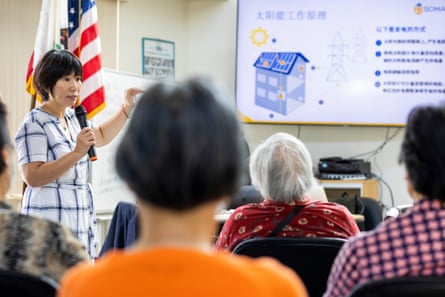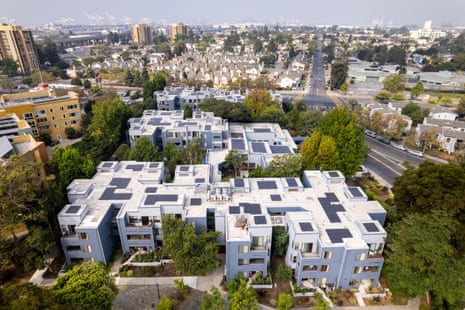Joseph Wang and his wife have figured out a way to stay warm and efficient during northern California’s winter nights: layering.
“We bundle up during the day, and at night. We use two blankets,” said Wang, 87, in Mandarin, explaining how he and his wife, Meng Rou Lan, 84, dealt with trying to save money on their electricity bill last winter. When he and his wife were hit with a $130 electricity bill, they decided to use their heater sparingly. But soon, due to a publicly funded statewide solar program in California, their bill may go down as much as $40 a month.
Wang is a resident of St Mary’s Gardens, an affordable housing complex with 100 units for low-income seniors in Oakland, California.
St Mary’s Gardens is one of more than 100 projects in California that have had solar panels installed as part of the state-funded Solar on Multifamily Affordable Housing (Somah) program. The state is allotting $100m a year in public funding starting in July 2019. By 2030, the program’s goal is to power 300 megawatts through new solar projects on low-income rental buildings across the state – akin to the amount of electricity generated by a small nuclear power plant, or enough to provide power to 150,000 tenant families.
The program provides financial assistance to owners of affordable housing buildings, and also education to tenants. A little more than 100 low-income rental buildings have completed solar installations through this project, and the owners of hundreds more are interested, according to Somah. The financial incentives saved through solar directly benefit low-income tenants, and the program is designed so that people who live in the most “disadvantaged communities” – those affected most by environmental pollution and the climate crisis – can benefit from multibillion-dollar investments in clean energy from the government.
“Our core goal is to give back to these vulnerable communities that sometimes lack voices in this space,” said Staci Givens, program manager of Somah.

California paved the way for solar programs, as one of the sunniest and largest states in the throes of worsening climate conditions. Solar panels have become popular to assist in energy conservation, and oftentimes have benefited wealthier neighborhoods. In an effort to make solar energy more equitable, the Biden-Harris administration approved a $7bn Solar for All program for states across the country.
According to a Lawrence Berkeley National Laboratory report on solar installations in the US, people who have solar panels on their rooftops are disproportionately high-income earners. California also has the most households with rooftop solar, comprising 50% of the US total. The overall snapshot of people who have solar tend to be middle-aged, white and primarily English-speaking, and work in business or finance and live in rural areas, according to the Berkeley Lab.
‘A deal we couldn’t pass up’
Gideon Anders said that when he first heard about the Somah program, he didn’t know much about the ins and outs of solar panels. As a board member and treasurer of the St Mary’s Gardens Elderly Housing Limited Partnership, he and other members decided to install solar because it was a great opportunity for the building and the residents.
“When we found out about the program, and we found the level of incentives that were being made available, we basically determined it was a deal that we couldn’t pass up,” Anders said.
Ayesha Abbasi, state organizer for Asian Pacific Environmental Network (Apen), an environmental and advocacy organization based in Oakland, California, approached the manager of the St Mary’s Gardens building as part of her outreach work. Apen helped to write the legislation that started Somah.
St Mary’s Gardens was a perfect candidate to benefit from the clean energy program: a building with low-income senior tenants, propped next to freeways and a port diesel corridor.

The total cost of installing solar energy in a building like St Mary’s Gardens is about $345,000, and it has taken three and a half years. “It was a lot of work put into making these projects [successful],” Abbasi said.
For St Mary’s Gardens, the entire cost of installation was covered by the state because the building doesn’t own the solar panels, but is contracting with Sunrun, a solar power company, to maintain the panels for the next 20 years, Anders said. Givens estimates that once PG&E approves the installation and connects to the grid, each unit could save from $30 to $40 a month.
The solar panel project led the building owners to pursue other clean energy ideas. Anders said they already upgraded the building’s common space HVAC system to an electric heat pump, and replaced gas water boilers with electric ones.
after newsletter promotion
However, getting buildings to install solar has some challenges. First, many people don’t have the technical skills or staffing to oversee a big construction project, Givens said. Somah does provide technical assistance to building owners, but it still requires a staff person to have time to manage the work.
Second, building owners may have to pay some out-of-pocket costs, whether upfront for the construction – a rebate is given only after solar has been installed and connected – or when signing a lease with a solar contractor.
Once contractors have installed solar panels, they have to wait for the electric company to inspect and hook them up to the grid, which can take some time – at least eight months.
But the larger goal for some is not only to financially benefit individuals and families, but to help contribute to the eventual closing down of coal-powered plants and the gradual reversal of the effects of the climate crisis.
“We need to scale it from these rooftops, to a region, to a state, to a country, in order to see an impact,” said Mari Rose Taruc, energy director at the California Environmental Justice Alliance. “We start from a roof, but we want to see it scale up.”
The seniors at St Mary’s Gardens said they want the environment to be cleaner because they have been affected by poor air quality from wildfires. “When the air pollution is bad, it is bad for us seniors,” YunHao Zhang, a resident at St Mary’s Gardens, said in Cantonese through a translator, Apen community organizer Sky Liang.
One resident said she wanted the program to help other seniors.
“We get to enjoy this green energy, but there are so many more low-income seniors out there like us who could benefit,” said Meng Rou Lan.
Editor’s note: this article was published in partnership with Oakland Voices, a journalism program led by the Maynard Institute for Journalism Education that trains Oakland residents to tell the stories of their neighborhoods
